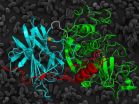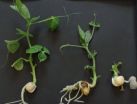(Press-News.org) This news release is available in German.
Researchers trying to get new information about the metabolism of plants can switch off individual genes and study the resulting changes. However, Erich Kombrink from the Max Planck Institute for Plant Breeding Research in Cologne and Markus Kaiser from the University of Duisburg-Essen adopt a different approach. They identify small molecules that block specific components of the metabolic process like brake pads and prevent the downstream reactions. In their search for these molecules, they use a biological selection process involving intact plants. This strategy has long been exploited in drug research. Its application in the plant sciences, however, is relatively new.
Kombrink, Kaiser and their colleagues have identified a molecule that interferes with the effect of jasmonic acid. This plant hormone influences flower formation, root growth, defence against herbivores and infections, wound healing, ageing of plants, and much more.
Although many questions about plant metabolism can be answered through targeted gene mutations, the method has its limits. This is also demonstrated in the case of jasmonic acid and its derivatives. So far, only one signalling chain has been discovered, but this cannot explain the wide-ranging effect of this plant hormone. Therefore, other hitherto undiscovered signalling paths and action mechanisms must exist. To find out more about them, Kombrink and Kaiser have adopted an approach that is similar to one used in medicine. Their strategy is based on the blocking of important metabolic pathways using low molecular weight compounds, which are easily assimilated by the plant. While in medical therapy such compounds are assimilated through the blood, in the plant they are introduced through the root.
The scientists embarked on their search with a screening of Arabidopsis thaliana and treating the plants with compounds in such a way that the desired selection could be identified by a conspicuous trait. Of the 1728 substances from a commercial compound library tested 16 emerged as inhibitors. This number was further reduced using more selective tests. In the end, only one substance turned out to be a specific inhibitor of the jasmonic acid signalling pathway and was given the name Jarin-1. "In terms of its basic structure, the substance is a plant alkaloid, whose two amino groups can carry different side chains," Kombrink explains. "However, its effect is associated with a particular side chain in one of the positions. Other side chains impair the activity of the substance. We also deliberately synthesised it once again to be certain that we had understood its chemical structure correctly."
The scientists also looked for the target of the newly discovered inhibitor. The known signalling chain starts with the conjugation of the jasmonic acid with the amino acid isoleucine by an enzyme called JAR1. The resulting pair leads to the expression – following various detours – of the genes necessary for the relevant effect of the jasmonic acid. Kombrink and Kaiser were able to show that JAR1 is the target of the newly discovered inhibitor. Due to the inhibition, the jasmonic acid conjugated with isoleucine does no longer accumulate in the cell. As a result genes are not expressed because the jasmonic acid–isoleucine pair no longer activates the genes' starting point.
The Jarin-1 inhibitor identified by Kombrink and Kaiser not only works in Arabidopsis but also in Cardamine hirsuta or hairy bittercress. "So we are obviously dealing with a broadly applicable molecule," comments Kombrink. Under the effect of the inhibitor, the plants show the same features as they do following the targeted mutation of genes from the jasmonic acid signalling pathway.
The scientists also investigated the exact location where the molecule takes effect. They succeeded in demonstrating that it binds to the active centre of JAR1 and inhibits the natural substrate. "Our molecule is not a classical competitive inhibitor," says Kombrink. "But its effect can be explained, at least in parts, by displacement of the substrate from its binding site."
Small molecules are interesting new tools for plant research. Through their work, the researchers show how it is possible to search for them systematically and to identify their molecular mode of action.
INFORMATION:
Original paper:
Christian Meesters et al.
A chemical inhibitor of jasmonate signaling targets JAR1 in Arabidopsis thaliana
Nature Chemical Biology, 17 August 2014, doi: 10.1038/nchembio.1591
Researchers block plant hormone
A small molecule inhibits jasmonic acid and helps to explain its effects
2014-08-19
ELSE PRESS RELEASES FROM THIS DATE:
Exporting US coal to Asia could drop emissions 21 percent
2014-08-19
DURHAM, N.C. -- Under the right scenario, exporting U.S. coal to power plants in South Korea could lead to a 21 percent drop in greenhouse gas emissions compared to burning the fossil fuel at plants in the United States, according to a new Duke University-led study.
"Despite the large amount of emissions produced by shipping the coal such a long distance, our analysis shows that the total emissions would drop because of the superior energy efficiency of South Korea's newer coal-fired power plants," said Dalia Patiño-Echeverri, assistant professor of energy systems and ...
The difficult question of Clostridium difficile
2014-08-19
The bacterium Clostridium difficile causes antibiotic-related diarrhoea and is a growing problem in the hospital environment and elsewhere in the community. Understanding how the microbe colonises the human gut when other "healthy" microbes have been destroyed during a course of antibiotics might lead to new ways to control infection. An important clue was reported recently in an open access article published in the journal Acta Crystallographica Section D Biological Crystallography. [Bradshaw et al. (2014). Acta Cryst. D70, 1983-1993; doi:10.1107/S1399004714009997]
Ravi ...
Zebrafish help to unravel Alzheimer's disease
2014-08-19
New fundamental knowledge about the regulation of stem cells in the nerve tissue of zebrafish embryos results in surprising insights into neurodegenerative disease processes in the human brain. A new study by scientists at VIB and KU Leuven identifies the molecules responsible for this process.
Zebrafish as a model
The zebrafish is a small fish measuring 3 to 5 cm in length, with dark stripes along the length of its body. They are originally from India, but also a popular aquarium fish. Zebrafish have several unusual characteristics that make them popular for scientific ...
Why global warming is taking a break
2014-08-19
Global warming is currently taking a break: whereas global temperatures rose drastically into the late 1990s, the global average temperature has risen only slightly since 1998 – surprising, considering scientific climate models predicted considerable warming due to rising greenhouse gas emissions. Climate sceptics used this apparent contradiction to question climate change per se – or at least the harm potential caused by greenhouse gases – as well as the validity of the climate models. Meanwhile, the majority of climate researchers continued to emphasise that the short-term ...
Has the puzzle of rapid climate change in the last ice age been solved?
2014-08-19
During the last ice age a large part of North America was covered with a massive ice sheet up to 3km thick. The water stored in this ice sheet is part of the reason why the sea level was then about 120 meters lower than today. Young Chinese scientist Xu Zhang, lead author of the study who undertook his PhD at the Alfred Wegener Institute, explains. "The rapid climate changes known in the scientific world as Dansgaard-Oeschger events were limited to a period of time from 110,000 to 23,000 years before present. The abrupt climate changes did not take place at the extreme ...
How steroid hormones enable plants to grow
2014-08-19
Plants are superior to humans and animals in a number of ways. They have an impressive ability to regenerate, which enables them to regrow entire organs. After being struck by lightning, for example, a tree can grow back its entire crown. But there is one major downside to life as a plant: They are quite literally rooted to the habitats in which they live and therefore completely at the mercy of the elements. In response to this dilemma, plants have developed mechanisms that enable them to rapidly adapt their growth and development to changes.
Plant hormones are important ...
First indirect evidence of so-far undetected strange baryons
2014-08-19
UPTON, NY-New supercomputing calculations provide the first evidence that particles predicted by the theory of quark-gluon interactions but never before observed are being produced in heavy-ion collisions at the Relativistic Heavy Ion Collider (RHIC), a facility that is dedicated to studying nuclear physics. These heavy strange baryons, containing at least one strange quark, still cannot be observed directly, but instead make their presence known by lowering the temperature at which other strange baryons "freeze out" from the quark-gluon plasma (QGP) discovered and created ...
Hope for healthy hearts revealed in naked mole rat studies
2014-08-19
SAN ANTONIO (Aug. 14, 2014) — Cardiovascular disease is the greatest killer of humans the world over, presenting huge financial and quality-of-life issues. It is well known that the heart becomes less efficient with age in all mammals studied to date, even in the absence of overt cardiac disease. However, scientists still don't have a good understanding of how to prevent these functional declines that ultimately may lead to debilitating cardiovascular disease.
The longest-lived rodent, the naked mole rat, beats these odds and escapes cardiovascular aging, at least to ...
Men fare worse than women in China regarding discrimination among obese workers
2014-08-19
New research that analyzes economic disparity among obese Chinese adults shows that there is no wage disparity for obese women in China, but there is pay inequality among obese men.
Women in China make less on average than men, but the study results showed no disparity in wages because of body weight. Results of the study for men showed increasing wage disparities by occupation when gaining weight.
The study, "The Obesity Pay Gap: Gender, Body Size, and Wage Inequalities: A Longitudinal Study of Chinese Adults, 1991-2009," which will be presented at the 109th Annual ...
Purdue ag economists: Shale oil 'dividend' could pay for smaller carbon footprint
2014-08-19
WEST LAFAYETTE, Ind. - Unanticipated economic benefits from the shale oil and gas boom could help offset the costs of substantially reducing the U.S.'s carbon footprint, Purdue agricultural economists say.
Wally Tyner and Farzad Taheripour estimate that shale technologies annually provide an extra $302 billion to the U.S. economy relative to 2007, a yearly "dividend" that could continue for at least the next two decades, Tyner said.
Using an economic model, they found that "spending" part of this dividend on slashing the nation's carbon emissions by about 27 percent ...
LAST 30 PRESS RELEASES:
Layered hydrogen silicane for safe, lightweight, and energy-efficient hydrogen carrier
Observing positronium beam as a quantum matter wave for the first time
IEEE study investigates the effects of pointing error on quantum key distribution systems
Analyzing submerged fault structures to predict future earthquakes in Türkiye
Quantum ‘alchemy’ made feasible with excitons
‘Revoice’ device gives stroke patients their voice back
USF-led study: AI helps reveal global surge in floating algae
New method predicts asthma attacks up to five years in advance
Researchers publish first ever structural engineering manual for bamboo
National poll: Less than half of parents say swearing is never OK for kids
Decades of suffering: Long-term mental health outcomes of Kurdish chemical gas attacks
Interactional dynamics of self-assessment and advice in peer reflection on microteaching
When aging affects the young: Revealing the weight of caregiving on teenagers
Can Canada’s health systems handle increased demand during FIFA World Cup?
Autistic and non-autistic faces may “speak a different language” when expressing emotion
No clear evidence that cannabis-based medicines relieve chronic nerve pain
Pioneering second-order nonlinear vibrational nanoscopy for interfacial molecular systems beyond the diffraction limit
Bottleneck in hydrogen distribution jeopardises billions in clean energy
Lung cancer death rates among women in Europe are finally levelling off
Scientists trace microplastics in fertilizer from fields to the beach
The Lancet Obstetrics, Gynecology, & Women’s Health: Taking paracetamol during pregnancy does not increase risk of autism, ADHD or intellectual disabilities, confirms new gold-standard evidence review
Taking paracetamol during pregnancy does not increase risk of autism, ADHD or intellectual disabilities
Harm reduction vending machines in New York State expand access to overdose treatment and drug test strips, UB studies confirm
University of Phoenix releases white paper on Credit for Prior Learning as a catalyst for internal mobility and retention
Canada losing track of salmon health as climate and industrial threats mount
Molecular sieve-confined Pt-FeOx catalysts achieve highly efficient reversible hydrogen cycle of methylcyclohexane-toluene
Investment in farm productivity tools key to reducing greenhouse gas
New review highlights electrochemical pathways to recover uranium from wastewater and seawater
Hidden pollutants in shale gas development raise environmental concerns, new review finds
Discarded cigarette butts transformed into high performance energy storage materials
[Press-News.org] Researchers block plant hormoneA small molecule inhibits jasmonic acid and helps to explain its effects





